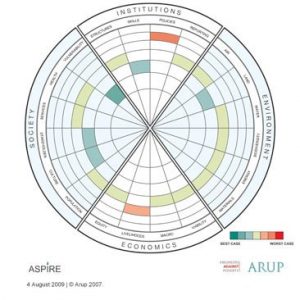ASPIRE provides an integrated planning, monitoring and evaluation tool for appraising the sustainability and poverty reduction performance of infrastructure projects. Developed through a unique partnership between EAP and Arup International Development, the ASPIRE framework examines the social, environmental, economic and institutional dimensions of sustainability. It helps stakeholders involved in funding, commissioning and implementing infrastructure projects to understand and evaluate the implications of infrastructure provision and its contribution to sustainable development throughout the project cycle.
ASPIRE was made possible through the generous support of the Institution of Civil Engineers R&D Enabling Fund and Arup’s Design Technical Fund.
The key features of ASPIRE are:
- Integrated evaluation of poverty & sustainability performance
- Inclusion of an institutional dimension
- Applicable throughout the project life cycle
- Software-based tool
- Clear graphical output
- Easy to use and understand
- Tested on a range of projects globally
Development process
ASPIRE is the product of a rigorous 3-year research and development process. The initial work developed a robust definition of ‘sustainable pro-poor infrastructure’ through extensive research and consultation with key stakeholders. It also sought to identify the primary characteristics of a tool to support the effective integration of sustainability and poverty reduction into infrastructure planning, design and delivery.
The outputs from this research were used to develop a pilot version of ASPIRE based on the modification of an existing Arup sustainability assessment tool called SPeAR. The pilot version was tested on nine projects in different locations including Kenya, Zambia, South Africa, Sri Lanka and the US. The feedback from this detailed testing process was used to produce the final version of ASPIRE.
For further information, please see the following useful documents:
The ASPIRE sustainability assessment framework
 ASPIRE utilises a comprehensive appraisal framework examining the four key dimensions of sustainability – environment, society, economics and institutions (see figure below). These four dimensions have been divided into 20 primary theme areas (e.g. water, biodiversity, livelihoods & employment) to assist in understanding for users. Each theme comprises of 4-5 sub-themes or indicators to assess the performance of a project in that specific area. The diagram recognises the dynamic between human development and the carrying capacity of the planet, in the context of the opportunities and constraints afforded by the economic and institutional environment.
ASPIRE utilises a comprehensive appraisal framework examining the four key dimensions of sustainability – environment, society, economics and institutions (see figure below). These four dimensions have been divided into 20 primary theme areas (e.g. water, biodiversity, livelihoods & employment) to assist in understanding for users. Each theme comprises of 4-5 sub-themes or indicators to assess the performance of a project in that specific area. The diagram recognises the dynamic between human development and the carrying capacity of the planet, in the context of the opportunities and constraints afforded by the economic and institutional environment.
The inclusion of the institutional quadrant reflects the need to ensure specific consideration of issues around governance, transparency and local capacity which are often disregarded as being beyond the scope of an infrastructure project or the remit of the participants. Historically, it has often been the absence or weakness of appropriate institutional structures and processes which have meant infrastructure developments have not benefited the poor or have resulted in unacceptable impacts on the environment.